Gamay Expressed in 8 Appellations by Beaujolais’ New Generation: A Wealth of Terroir (10-Bottle Pack $298, Tax Included)
A few miles north of Lyon lies Beaujolais, a storied French wine appellation that overlaps both Burgundy and the Rhône, paying homage to both while owing allegiance to neither. The picturesque vineyards are planted almost exclusively to Gamay for reds and have been producing accessible, fruit-forward wines since the Romans first established trading routes along the Saône valley. Nearby Lyon is said to be ‘a city of three rivers’—the Rhône and Saône rivers that converge here, and then, the river of cool Beaujolais wine that drenches its food-centered heart. With 4300 restaurants (including twenty that boast Michelin stars), Lyon is host to such internationally renowned chefs as Paul Bocuse and Guy Lassausaie, and has rightly been nicknamed ‘The Gastronomic Capital of the World.’
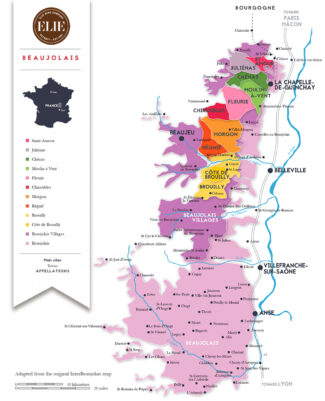 Beaujolais is filled with rolling hills and bucolic villages, unique in France in that relatively inexpensive land has allowed a number of dynamic new wine producers to enter the business. In the flatter south, easy-drinking wines are generally made using technique known as carbonic maceration, an anaerobic form of closed-tank fermentation that imparts specific, recognizable flavors (notably, bubblegum and Concord grape). Often sold under the Beaujolais and Beaujolais-Villages appellations, such wines tend to be simple, high in acid and low in tannin, and are ideal for the local bistro fare. Beaujolais’ suppler wines generally come from the north, where the granite hills are filled with rich clay and limestone. These wines are age-worthy, and show much more complexity and depth. The top of Beaujolais’ classification pyramid is found in the north, especially in the appellations known as ‘Cru Beaujolais’: Brouilly, Chénas, Chiroubles, Côte de Brouilly, Fleurie, Juliénas, Morgon, Moulin-à-Vent, Regnié and Saint-Amour. Each are distinct wines with definable characteristics and individual histories; what they have in common beyond Beaujolais real estate is that they are the pinnacle of Gamay’s glory in the world of wine.
Beaujolais is filled with rolling hills and bucolic villages, unique in France in that relatively inexpensive land has allowed a number of dynamic new wine producers to enter the business. In the flatter south, easy-drinking wines are generally made using technique known as carbonic maceration, an anaerobic form of closed-tank fermentation that imparts specific, recognizable flavors (notably, bubblegum and Concord grape). Often sold under the Beaujolais and Beaujolais-Villages appellations, such wines tend to be simple, high in acid and low in tannin, and are ideal for the local bistro fare. Beaujolais’ suppler wines generally come from the north, where the granite hills are filled with rich clay and limestone. These wines are age-worthy, and show much more complexity and depth. The top of Beaujolais’ classification pyramid is found in the north, especially in the appellations known as ‘Cru Beaujolais’: Brouilly, Chénas, Chiroubles, Côte de Brouilly, Fleurie, Juliénas, Morgon, Moulin-à-Vent, Regnié and Saint-Amour. Each are distinct wines with definable characteristics and individual histories; what they have in common beyond Beaujolais real estate is that they are the pinnacle of Gamay’s glory in the world of wine.
Moulin-à-Vent
At the top of Beaujolais, geographically and arguably, in terms of quality, Moulin-à-Vent’s oddly toxic soils produce wines of great merit. Manganese exists here in quantities not found anywhere else in Beaujolais; it retards leaf growth and creates smaller bunches, resulting in wines of phenomenal concentration that can be cellared for a decade or more.
 In the 18th century Château du Moulin-à-Vent was called Château des Thorins, named for the renowned vines on the hillsides of Thorins—a Mâconnais proverb runs, “Every wine is good with a meal, but a meal cannot be enjoyed without Thorins.” The estate was purchased in 2009 by the Parinet family, who has made a marvelous effort to extract the most from the chemical-rich terroir—the underlying granite soil contains iron oxide, copper and, of course, manganese. Château du Moulin-à-Vent, Moulin-à-Vent – Le Moulin-à-Vent 2018, ($40), comes from an exceptional vintage and is one of the château’s signature wines, sumptuous and expressive. It shows juicy black fruits, lavender and a myriad spices from the partial oak-aging.
In the 18th century Château du Moulin-à-Vent was called Château des Thorins, named for the renowned vines on the hillsides of Thorins—a Mâconnais proverb runs, “Every wine is good with a meal, but a meal cannot be enjoyed without Thorins.” The estate was purchased in 2009 by the Parinet family, who has made a marvelous effort to extract the most from the chemical-rich terroir—the underlying granite soil contains iron oxide, copper and, of course, manganese. Château du Moulin-à-Vent, Moulin-à-Vent – Le Moulin-à-Vent 2018, ($40), comes from an exceptional vintage and is one of the château’s signature wines, sumptuous and expressive. It shows juicy black fruits, lavender and a myriad spices from the partial oak-aging.
Chiroubles
Chiroubles is relatively tiny, with fewer than a thousand acres under vine, but it is a mouse that roars. This is due mostly to elevation; Chiroubles vineyards are the highest in Beaujolais, with some planted 1500 feet above the Saône River valley. Taking advantage of extreme diurnal shifts between the warm days and cold nights, the same soils that produce Fleurie to its immediate north here build wines that are lighter and fresher, often with pronounced floral characteristics.
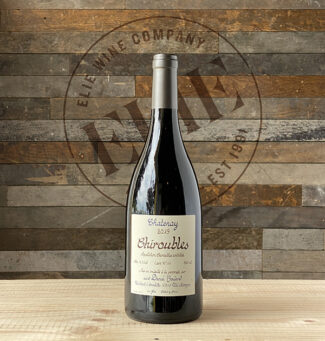 Daniel Bouland is an artisan in the style of old-school winemakers. He works his vines by hand, and many are grown in small plots known as lieu-dits—portions of a vineyard with specific topographic or historical significance. Better known for his Morgons, Daniel Bouland ‘Cuve No 11’, Chiroubles-Chatenay 2019, ($36), hails from such a lieu-dit (Chatenay) in the neighboring appellation of Chiroubles, on a steep hillside site composed of friable sandstone. Such terroir produces beautiful, fragrant, sappy Gamay wines with the structure of many Burgundies. It has a nose of violets and thyme, a rich mid-palate of cherry and cranberry underscored by orange peel, Damson plum and crisp minerality.
Daniel Bouland is an artisan in the style of old-school winemakers. He works his vines by hand, and many are grown in small plots known as lieu-dits—portions of a vineyard with specific topographic or historical significance. Better known for his Morgons, Daniel Bouland ‘Cuve No 11’, Chiroubles-Chatenay 2019, ($36), hails from such a lieu-dit (Chatenay) in the neighboring appellation of Chiroubles, on a steep hillside site composed of friable sandstone. Such terroir produces beautiful, fragrant, sappy Gamay wines with the structure of many Burgundies. It has a nose of violets and thyme, a rich mid-palate of cherry and cranberry underscored by orange peel, Damson plum and crisp minerality.
Côte de Brouilly
To suggest that Côte de Brouilly erupts with flavor is more than a metaphor; the appellation sits on the slope of an extinct volcano. Making up but a small fraction of the Brouilly appellation, Côte de Brouilly draws its unique terroir from volcanic blue diorite, which provides the thin, well-drained soil that causes vines to struggle and the resulting wine—concentrated and intense—to shine. The vineyards of Côte de Brouilly are found on the south and east slopes of Mont Brouilly, protected from winds from the nearby Beaujolais hills by the volcano itself. They enjoy morning sunlight maximized by the steep slopes of the vineyards. This hastens ripening so that the vineyards of Côte de Brouilly are among the first to be harvested in Beaujolais.
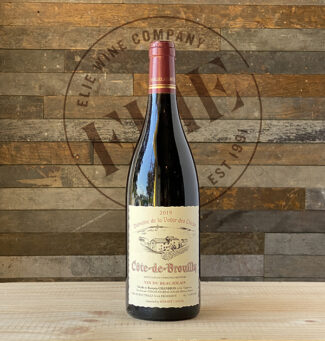 Domaine de la Voûte des Crozes, Côte de Brouilly 2019, ($23). So highly is La Voûte des Crozes winemaker Nicole Chanrion regarded in Côte-de-Brouilly that in 2000, she was elected president of the appellation. With oversight of all aspects of the process, from winter pruning, to managing the canopy, hand-harvesting and fermentation, she produces a wine whose tannins match ripeness of the fruit. Ample and layered with a succulent core of black-cherry, the acid remains front and center while a streak of minerality reflects the volcanic schist terroir.
Domaine de la Voûte des Crozes, Côte de Brouilly 2019, ($23). So highly is La Voûte des Crozes winemaker Nicole Chanrion regarded in Côte-de-Brouilly that in 2000, she was elected president of the appellation. With oversight of all aspects of the process, from winter pruning, to managing the canopy, hand-harvesting and fermentation, she produces a wine whose tannins match ripeness of the fruit. Ample and layered with a succulent core of black-cherry, the acid remains front and center while a streak of minerality reflects the volcanic schist terroir.
 The artisan vigneron reappears in Côte de Brouilly with Daniel Bouland ‘Cuvée Mélanie Cuve No 1’, Côte de Brouilly 2019, ($36), a wine comparable in complexity, depth and cellaring potential to a Côte de Beaune. Another lieu-dit gem, this wine shows kirsch fragrances along with cassis, blackberry and smoke. Like all of Bouland’s wines, this one is made from hand-harvested grapes, vinified with full clusters and bottled unfiltered.
The artisan vigneron reappears in Côte de Brouilly with Daniel Bouland ‘Cuvée Mélanie Cuve No 1’, Côte de Brouilly 2019, ($36), a wine comparable in complexity, depth and cellaring potential to a Côte de Beaune. Another lieu-dit gem, this wine shows kirsch fragrances along with cassis, blackberry and smoke. Like all of Bouland’s wines, this one is made from hand-harvested grapes, vinified with full clusters and bottled unfiltered.
Saint-Amour
The wines of Saint-Amour are light and delicate, the result of dry, warm winds from the north that keeps soils feathery-textured; although Gamay is the predominant varietal, it’s no wonder that this appellation produces more white wines than the other Beaujolais cru, although these Chardonnay/Aligoté -based wines often wear generic labels or are listed under the Saint-Véran (Burgundy) appellation that slightly overlaps Saint-Amour.
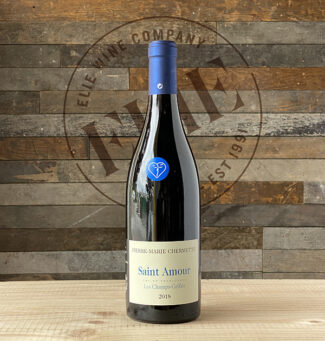 Pierre-Marie Chermette was raised in the vineyard; his fondest memories of the family home in Vissoux was riding the tractor. He pursued it as his life’s work, earning a National Diploma of Oenologist from Dijon at the age of 20. Two years later, he convinced his father to stop selling the fruits of his labor to merchants, and developed the market for estate bottled wines. Over the years, Pierre-Marie diversified the number of appellations the family worked, and is now responsible for nearly 75 acres. For obvious reasons, Pierre-Marie Chermette, Saint-Amour-Les Champs Grilles 2018, ($30) is marketed for Valentine’s Day, for which it is perfectly suited: The nose is rose petals and cherry blossoms, and the palate is filled with lush red fruits and chocolate layered across gentle tannins.
Pierre-Marie Chermette was raised in the vineyard; his fondest memories of the family home in Vissoux was riding the tractor. He pursued it as his life’s work, earning a National Diploma of Oenologist from Dijon at the age of 20. Two years later, he convinced his father to stop selling the fruits of his labor to merchants, and developed the market for estate bottled wines. Over the years, Pierre-Marie diversified the number of appellations the family worked, and is now responsible for nearly 75 acres. For obvious reasons, Pierre-Marie Chermette, Saint-Amour-Les Champs Grilles 2018, ($30) is marketed for Valentine’s Day, for which it is perfectly suited: The nose is rose petals and cherry blossoms, and the palate is filled with lush red fruits and chocolate layered across gentle tannins.
Morgon
Morgon, on the western side of the Saône, may only appear on the label of a Gamay-based red wine; even so, the appellation allows the addition of up to 15% white wine grapes: Chardonnay, Aligoté or Melon de Bourgogne. Nevertheless, the wines of Morgon wind up being among the most full-bodied in Beaujolais, with the potential to improve in the cellar so consistently that the French describe wines from other AOPs that display this quality by saying, “It Morgons…” The vineyards occupy slightly under five square miles surrounding the commune of Villié-Morgon, with the vines of Fleurie and Chiroubles directly to the north and Brouilly and Regnié along the southern border.
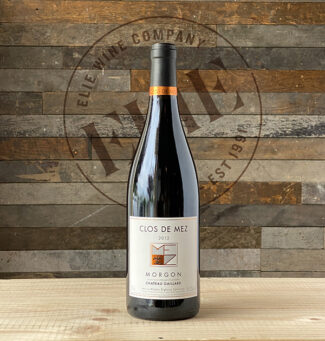 Marie-Élodie Zighera-Confuron is the proprietor of Clos de Mez, and maintains the vineyards’ matriarchal lineage. She explains, “Vines have been in my maternal family for four generations. The grapes they grew were delivered to the cooperative cellar by my grandmother and mother, up until I arrived at the domain as a winegrower. However, this did not deter my grandmother or mother from taking great care of the vineyard.” Clos de Mez, Morgon-Château Gaillard 2012, ($22)is not to be confused with Normandy’s Château Gaillard; here it is a lieu-dit in the northern part of Morgon bordering on Fleurie. The vines are all over 60 years old; they produce a distinctive, meaty wine that has been compared to a Rhône for its dark cherry profile enlivened by licorice, plum and a taut, mineral-tinged acidity.
Marie-Élodie Zighera-Confuron is the proprietor of Clos de Mez, and maintains the vineyards’ matriarchal lineage. She explains, “Vines have been in my maternal family for four generations. The grapes they grew were delivered to the cooperative cellar by my grandmother and mother, up until I arrived at the domain as a winegrower. However, this did not deter my grandmother or mother from taking great care of the vineyard.” Clos de Mez, Morgon-Château Gaillard 2012, ($22)is not to be confused with Normandy’s Château Gaillard; here it is a lieu-dit in the northern part of Morgon bordering on Fleurie. The vines are all over 60 years old; they produce a distinctive, meaty wine that has been compared to a Rhône for its dark cherry profile enlivened by licorice, plum and a taut, mineral-tinged acidity.
Fleurie
As mentioned, each of the Beaujolais crus wears its own pretty face; where Morgon is bold and handsome and Saint-Amour is a fairyland of delicate beauty, Fleurie—covering an unbroken area of three square miles—represents Beaujolais’ elegance. The terroir is built around pinkish granite that is unique to this part of Beaujolais, with the higher elevations accounting for thinner, acidic soils that produce graceful and aromatic wines. Below the main village, the wines are grown in deeper, richer, clay-heavy soils and the wines themselves are richer and deeper and appropriate for the cellar. The technique known as gridding, which involves extracting more color and tannin from the skins of the grapes, is proprietary to Fleurie.
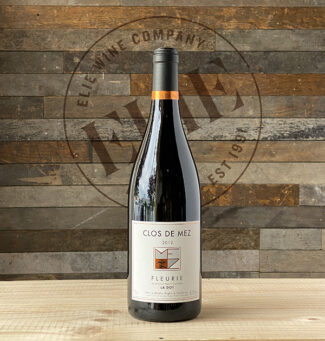 Clos de Mez, Fleurie-La Dot 2012, ($22)sees the return of Marie-Élodie Zighera-Confuron to her native Fleurie, where La Dot refers to a plot of vines, now fifty years old, that her grandmother once received as a dowry. White flowers and cut grass waft through the nose and lead to a beautiful palate of pomegranate and raspberry; the wine finishes with granitic acidity and a dusting of baking spices.
Clos de Mez, Fleurie-La Dot 2012, ($22)sees the return of Marie-Élodie Zighera-Confuron to her native Fleurie, where La Dot refers to a plot of vines, now fifty years old, that her grandmother once received as a dowry. White flowers and cut grass waft through the nose and lead to a beautiful palate of pomegranate and raspberry; the wine finishes with granitic acidity and a dusting of baking spices.
 Pierre-Marie Chermette, Fleurie-Poncié 2017 ($27) also reintroduces the tractor-fan turned enologist from Le Vissoux. Although the family estate is in Saint-Vérand, in the Golden Stone area of Rhône, the luscious Fleurie from the lieu-dit Poncié is a paean to the sandy slopes of pink granite north of the town itself. The wine is resplendent with sweet red cherries, dried flowers and ripe strawberries enveloped in silky tannins.
Pierre-Marie Chermette, Fleurie-Poncié 2017 ($27) also reintroduces the tractor-fan turned enologist from Le Vissoux. Although the family estate is in Saint-Vérand, in the Golden Stone area of Rhône, the luscious Fleurie from the lieu-dit Poncié is a paean to the sandy slopes of pink granite north of the town itself. The wine is resplendent with sweet red cherries, dried flowers and ripe strawberries enveloped in silky tannins.
Beaujolais-Villages
Of the three Beaujolais classifications, Villages occupies the middle spot in terms of quality. To qualify, the wine generally hails from more esteemed terroirs in the northern half of Beaujolais, from one of 38 villages that have not been named ‘cru’ appellations. They are expressive wines with more structure and complexity than generic Beaujolais, though not as exclusive as those from the ten crus. Accounting for about a quarter of all Beaujolais production, Villages wines are most often produced by négociants and vinified using stricter rules as to yields and technique.
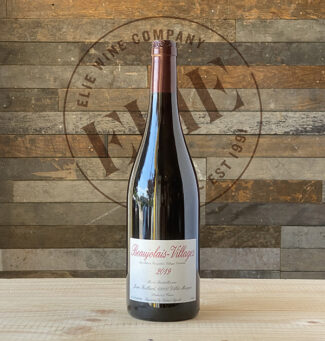 Jean Foillard, Beaujolais-Villages 2019, ($27), is a solid example of the classification, brilliant red with a purplish tint, offering round, juicy mouth-filling strawberry and cherry flavors with spice in the background and a rustic, lightly tannic finish. A disciple of traditionalist Jules Chauvet, who eschewed the styles touted by commercial brands, Jean Foillard produces wines that are sumptuous and complex, with a velvety lushness that makes them irresistible in their youth.
Jean Foillard, Beaujolais-Villages 2019, ($27), is a solid example of the classification, brilliant red with a purplish tint, offering round, juicy mouth-filling strawberry and cherry flavors with spice in the background and a rustic, lightly tannic finish. A disciple of traditionalist Jules Chauvet, who eschewed the styles touted by commercial brands, Jean Foillard produces wines that are sumptuous and complex, with a velvety lushness that makes them irresistible in their youth.
Beaujolais
Brooding Beaujolais is an oxymoron; buoyant Beaujolais is a requirement. The broadest of all the classifications in Beaujolais, seeing such a designation on a wine label means that the grapes are generally grown in the southern part of the appellation and vinified using carbonic or semi-carbonic maceration, leaving dominant, candy-like notes. Beaujolais’ climate is similar to Burgundy—moderate continental—and the main difference in the output is that whereas Burgundy’s Pinot Noir is fickle and difficult to ripen, Beaujolais’ rock star Gamay is an early-budding, early-ripening and vigorous cultivar. As such, outputs (if not controlled) can be overly prodigious.
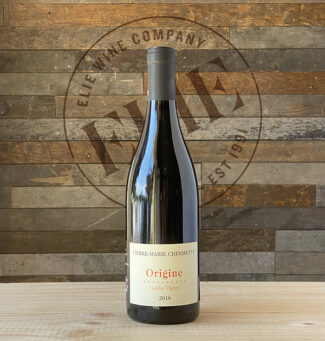 Pierre-Marie Chermette ‘Origine Vieilles Vignes’ Beaujolais 2018, ($18), falls under this generic appellation with the specification of ‘Origine Vieilles Vignes’, or ‘original old vines’. It is produced in Saint Vérand from vines that have grown on a dark granite enclave for up to a century. The cuvée was created in 1986 when banana-flavored Beaujolais Nouveau was in vogue; Pierre-Marie wanted to create a non-chaptalized spring-release Beaujolais using natural yeast and vinified by using traditional methods. It is bright and beautiful, suave and supple, and exhibiting great color and freshness.
Pierre-Marie Chermette ‘Origine Vieilles Vignes’ Beaujolais 2018, ($18), falls under this generic appellation with the specification of ‘Origine Vieilles Vignes’, or ‘original old vines’. It is produced in Saint Vérand from vines that have grown on a dark granite enclave for up to a century. The cuvée was created in 1986 when banana-flavored Beaujolais Nouveau was in vogue; Pierre-Marie wanted to create a non-chaptalized spring-release Beaujolais using natural yeast and vinified by using traditional methods. It is bright and beautiful, suave and supple, and exhibiting great color and freshness.
- - -
Posted on 2021.06.15 in France, Beaujolais, Wine-Aid Packages
Featured Wines
- Notebook: A’Boudt Town
- Saturday Sips Wines
- Saturday Sips Review Club
- The Champagne Society
- Wine-Aid Packages
Wine Regions
Grape Varieties
Aglianico, Albarino, Albarín Blanco, Albarín Tinto, Albillo, Aleatico, Arbanne, Aubun, Barbarossa, barbera, Beaune, Biancu Gentile, bourboulenc, Cabernet Franc, Cabernet Sauvignon, Caino, Caladoc, Calvi, Carcajolu-Neru, Carignan, Chablis, Chardonnay, Chasselas, Clairette, Corvina, Cot, Counoise, Erbamat, Ferrol, Fiano, Frappato, Friulano, Fromenteau, Fumin, Garnacha, Gewurztraminer, Godello, Graciano, Grenache, Grolleau, Groppello, Juan Garcia, Lambrusco, Loureira, Macabeo, Macabou, Malvasia, Malvasia Nera, Marsanne, Marselan, Marzemino, Melon de Bourgogne, Merlot, Mondeuse, Montanaccia, Montepulciano, Morescola, Morescono, Moscatell, Muscadelle, Muscat, Natural, Nero d'Avola, Parellada, Patrimonio, Petit Meslier, Petit Verdot, Pineau d'Aunis, Pinot Auxerrois, Pinot Blanc, Pinot Gris, Pinot Meunier, Pinot Noir, Poulsard, Prieto Picudo, Rondinella, Rousanne, Roussanne, Sangiovese, Sauvignon Blanc, Savignin, Semillon, Souson, Sparkling, Sumoll, Sylvaner, Syrah, Tannat, Tempranillo, Trebbiano, Trebbiano Valtenesi, Treixadura, Trousseau, Ugni Blanc, vaccarèse, Verdicchio, Vermentino, Viognier, Viura, Xarel-loWines & Events by Date
- April 2024
- March 2024
- February 2024
- January 2024
- December 2023
- November 2023
- October 2023
- September 2023
- August 2023
- July 2023
- June 2023
- May 2023
- April 2023
- March 2023
- February 2023
- January 2023
- December 2022
- November 2022
- October 2022
- September 2022
- August 2022
- July 2022
- June 2022
- May 2022
- April 2022
- March 2022
- February 2022
- January 2022
- December 2021
- November 2021
- October 2021
- September 2021
- August 2021
- July 2021
- June 2021
- May 2021
- April 2021
- March 2021
- February 2021
- January 2021
- December 2020
- November 2020
- October 2020
- September 2020
- August 2020
- July 2020
- June 2020
- May 2020
- April 2020
- March 2020
- February 2020
- January 2020
- December 2019
- November 2019
- October 2019
- September 2019
- August 2019
- July 2019
- June 2019
- May 2019
- April 2019
- March 2019
- February 2019
- January 2019
- December 2018
- November 2018
- October 2018
- September 2018
- August 2018
- July 2018
- June 2018
- May 2018
- April 2018
- March 2018
- February 2018
- January 2018
- December 2017
- November 2017
- October 2017
- September 2017
- August 2017
- July 2017
- June 2017
- May 2017
- April 2017
- March 2017
- February 2017
- January 2017
- December 2016
- November 2016
- October 2016
- September 2016
- August 2016
- July 2016
- June 2016
- May 2016
- April 2016
- March 2016
- February 2016
- January 2016
- December 2015
- November 2015
- October 2015
- September 2015
- August 2015
- July 2015
- June 2015
- May 2015
- April 2015
- March 2015
- February 2015
- January 2015
- December 2014
- November 2014
- October 2014
- September 2014
- August 2014
- July 2014
- June 2014
- April 2014
- March 2014
- February 2014
- January 2014
- December 2013
- November 2013
- October 2013
- September 2013
- August 2013
- July 2013
- June 2013
- May 2013
- April 2013
- March 2013
- February 2013
- January 2013
- December 2012
- November 2012
- October 2012
- February 2004
Search



